Related Research Articles
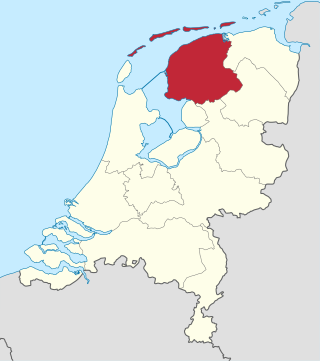
Friesland, historically and traditionally known as Frisia, named after the Frisians, is a province of the Netherlands located in the country's northern part. It is situated west of Groningen, northwest of Drenthe and Overijssel, north of Flevoland, northeast of North Holland, and south of the Wadden Sea. As of January 2020, the province had a population of 649,944 and a total area of 5,749 km2 (2,220 sq mi).
The Frisians are an ethnic group indigenous to the coastal regions of the Netherlands and northwestern Germany. They inhabit an area known as Frisia and are concentrated in the Dutch provinces of Friesland and Groningen and, in Germany, East Frisia and North Frisia. The name is probably derived from frisselje. The Frisian languages are spoken by more than 500,000 people; West Frisian is officially recognised in the Netherlands, and North Frisian and Saterland Frisian are recognised as regional languages in Germany.

The House of Orange-Nassau is the current reigning house of the Netherlands. A branch of the European House of Nassau, the house has played a central role in the politics and government of the Netherlands and elsewhere in Europe, particularly since William the Silent organised the Dutch Revolt against Spanish rule, which after the Eighty Years' War (1568–1648) led to an independent Dutch state.
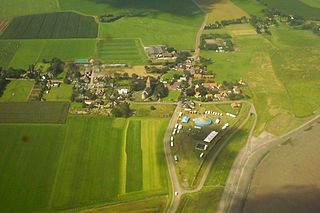
Wieringen is part of the municipality of Hollands Kroon, established in 2012 in the province of North Holland in the Netherlands. It is a former municipality in this province, with its name appearing in records of the late 9th and early 10th century. From 1200 it was known as an island, also named Wieringen, which was separated by water from the mainland during one of the disastrous storm floods towards the end of the late Middle Ages that changed the coastline. By draining, dikes and landfill from 1924 to 1932, the island was rejoined to the mainland.

West Friesland is a contemporary region in the Northwest of the Netherlands, in the province of North Holland.

The counts of Holland ruled over the County of Holland in the Low Countries between the 10th and the 16th century.
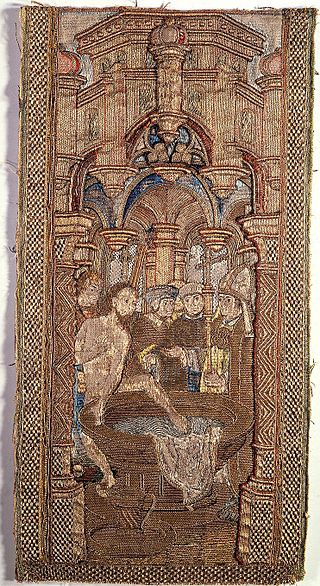
Redbad or Radbod was the king of Frisia from c. 680 until his death. He is often considered the last independent ruler of Frisia before Frankish domination. He defeated Charles Martel at Cologne. Eventually, Charles prevailed and compelled the Frisians to submit. Redbad died in 719, but for some years his successors struggled against the Frankish power.

The County of Holland was a state of the Holy Roman Empire and from 1433 part of the Burgundian Netherlands, from 1482 part of the Habsburg Netherlands and from 1581 onward the leading province of the Dutch Republic, of which it remained a part until the Batavian Revolution in 1795. The territory of the County of Holland corresponds roughly with the current provinces of North Holland and South Holland in the Netherlands.

The Leeuwarder Courant is the oldest daily newspaper in the Netherlands. Founded by Abraham Ferwerda, it first appeared in 1752. The Leeuwarder Courant was the first paper in the Dutch province Friesland and its capital Leeuwarden. It is considered a "popular" newspaper.
The Friso-Hollandic Wars, also called Frisian-Hollandic Wars, were a series of short medieval wars consisting of the attempts made by the counts of Holland to conquer the free Frisian territories, which lay to the north and east of their domain. These wars were waged off and on from 1256 to 1297, 1324 to 1348, 1396 to 1411, and from 1421 to 1422, although it could be argued that a state of war continued to exist between the County of Holland and the Frisian territories till well after the year 1500.
Gerolf or Gerulf was the second count of this name who is attested in the area of Friesland. Gerolf's main area of power seems to have been in Kennemerland. Count Gerolf is often regarded as the founder of the County of Holland, although the actual name "Holland" is from a later time. His ancestry is unclear, but he may have been a son or, more likely, a grandson of the earlier Gerolf, who was a count in the area of Frisia at the time of the reign of Emperor Louis the Pious and who later joined a monastery. The earlier Gerolf died in 855. There is some limited and vague evidence that this earlier Gerolf was a son of a certain Theodoric, who in turn supposedly descended from the Frisian king Redbad. Count Gerolf is often identified as the father of Count Dirk I and seen as the founder of the first house of the Counts of Holland, which ruled the county until it was inherited by John II of Hainaut in 1299.

Frisian freedom was the absence of feudalism and serfdom in Frisia, the area that was originally inhabited by the Frisians. Historical Frisia included the modern provinces of Friesland and Groningen, and the area of West Friesland, in the Netherlands, and East Friesland in Germany. During the period of Frisian freedom the area did not have a sovereign lord who owned and administered the land. The freedom of the Frisians developed in the context of ongoing disputes over the rights of local nobility.
Arnulf, also known as Arnoud or Arnold, succeeded his father in 988 as Count of Frisia, which by around AD 1100 would come to be referred to as the county of Holland. He was born in 951 in Ghent and because of this he is also known as Arnulf of Ghent. Arnulf was the son of Dirk II, Count of Holland and Hildegard of Flanders. He was named after his maternal grandfather.
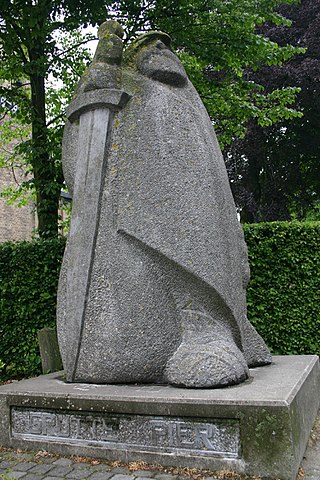
Frisia has changed dramatically over time, both through floods and through a change in identity. It is part of the Nordwestblock which is a hypothetical historic region linked by language and culture,where they may have spoken an Indo-European language which was neither germanic nor celtic.

The Frisian Kingdom, also known as Magna Frisia, is a modern name for the post-Roman Frisian realm in Western Europe in the period when it was at its largest (650–734). This dominion was ruled by kings and emerged in the mid-7th century and probably ended with the Battle of the Boarn in 734 when the Frisians were defeated by the Frankish Empire. It lay mainly in what is now the Netherlands and – according to some 19th century authors – extended from the Zwin near Bruges in Belgium to the Weser in Germany. The center of power was the city of Utrecht.
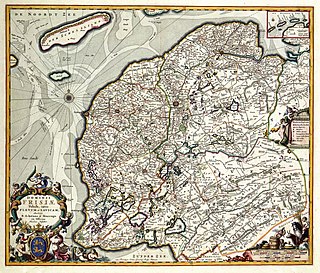
The Lordship of Frisia or Lordship of Friesland was a feudal dominion in the Netherlands. It was formed in 1498 by King Maximilian I and reformed in 1524 when Emperor Charles V conquered Frisia.
Gerulf, also Gerulf the Elder, was the first count of Frisia by this name and an ancestor of the Counts of Holland. Initially dispossessed for opposing emperor Louis the Pious, Gerulf was given back his lands in 839.
The Anglo-Saxon settlement in the Netherlands was a movement of continental Angles, Saxons, Franks and possibly English Anglo-Saxons into the lands formerly inhabited by the ancient Frisii, Cananefates and Batavians. These migrations occurred after the population drop of the Frisii during the 5th century up until the 7th century. These new migrants from northwestern Germany were later referred to as the Frisians by the Merovingian Franks who may have taken this name from older Roman historiography. During these migrations, almost the entire population of the coastal Netherlands was demographically replaced.
References
- ↑ Blok, Dirk Peter (1979). De Franken in Nederland (in Dutch). Haarlem: Fibula-Van Dishoeck. p. 86. ISBN 978-9022837399.
- 1 2 3 Jaekel, Hugo (1895). Die Grafen von Mittelfriesland aus dem Geschlechte König Ratbods (in German). Gotha: Friedrich Andreas Perthes. pp. 34–67. Retrieved 1 June 2017.
- 1 2 Vanderkindere, Léon (1902). La Formation Territoriale des Principautés Belges au Moyen Âge, Tome II (in French). Brussels: H. Lamertin. pp. 286–287. ISBN 978-1279506240 . Retrieved 1 June 2017.
- ↑ van den Bergh, Laurent Philippe Charles (1852). Handboek der Middle-nederlandschie Geographie (in Dutch). Leiden: E. J. Brill. p. 141. ISBN 978-1246269437 . Retrieved 1 June 2017.